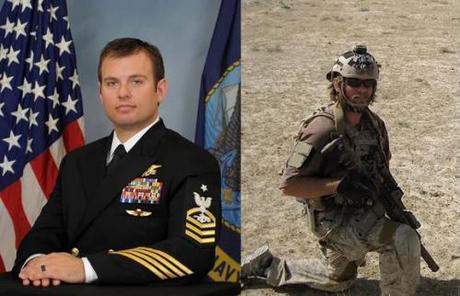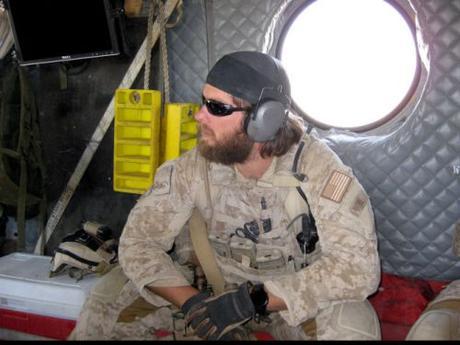Hooah!

Via USA Today: Chief Special Warfare Operator Edward Byers was the second one through the door as his SEAL Team Six unit raided a Taliban hide-out where an American doctor was held hostage.
Inside, he saw an unknown man darting for the corner of the room. Not knowing whether the man was a militant grabbing a gun or a hostage diving for cover, Byers tackled him to the floor. When Byers heard the hostage identify himself, he threw himself on top of the doctor to protect him from gunfire, even as he pinned the enemy against the wall with his hand to the enemy’s throat.
Byers’ role in the rescue mission, a tightly held secret until early February, has earned him the Medal of Honor. President Obama will present the highest military honor to Byers at the White House today.
Byers’ commendation cites only “his courageous actions while serving as part of a team that rescued an American civilian being held hostage in Afghanistan, December 8-9, 2012.” The awarding of the Medal of Honor provides a unique view into the mission in 2012 to rescue the American doctor and how the elite and secretive Navy SEAL unit operates.
Dilip Joseph was the medical director for a faith-based Colorado non-profit group establishing medical clinics in remote parts of Afghanistan when he was captured for ransom with his driver and translator. Four days later, having information that Joseph might be moved to Pakistan, U.S. commanders organized a rescue team, according to an unclassified summary of the mission obtained by USA TODAY.

Byers and the team walked four hours through the Afghan mountains to reach the Taliban compound, arriving shortly after midnight Dec. 9, 2012. Their mission relied on surprise and speed, and everyone on the team volunteered for the mission. “Trading personal security for speed of action was inherent to the success of this rescue mission,” a Navy report said.
Inside, the hostage — going into his fifth day of captivity — heard dogs barking and sheep bleating outside the small stone-and-mud shack. Two of his captors went out to investigate, then came back and conferred quietly, evidently seeing nothing outside.
Joseph had a runny nose and tried to clear it with a well-used handkerchief quietly, so as not to offend Afghan sensibilities about blowing one’s nose in public. He was on the edge of sleep when he heard the first gunshots, he recounted in a 2014 book, Kidnapped by the Taliban: A Story of Terror, Hope, and Rescue by SEAL Team Six.
The SEAL team, about 80 feet from the building, had been spotted by a guard. The forward-most SEAL, Petty Officer 1st Class Nicolas Checque, shot at the guard, who escaped inside. Checque followed him and was shot. Byers was second through the door. As he tackled an enemy fighter — adjusting his night-vision goggles even as he struggled — a teammate tried to locate the hostage.
“Is Dilip Joseph here?” the teammate shouted, according to Joseph’s account. When he identified himself, one of the SEALs — now known to be Byers — immediately laid down on top of him to protect him from the fighting. Amid the gunfire, Byers calmly asked if he had been fed, if he could walk and if he had been mistreated. Even as he did so, Byers pinned the last Taliban fighter to the wall, allowing his fellow team members to shoot and kill him, the Navy report said.
Five Taliban fighters were killed that night. One Navy SEAL — the first one in the door, who the others called Nic — had been shot in the forehead.
As they waited for a helicopter 12 minutes away, the SEALs protected Joseph by “sandwiching” him between two team members, Joseph said. The one in front of Joseph kept calling to the one behind him, named “Ed,” the only other name Joseph heard that night or since. That man, he now knows for the first time, was Byers.
“What are you doing?” asked the one in front. “Praying for Nic,” said the one named Ed. “Praying that he’ll be OK.”
Byers and other medics attempted to perform CPR on Checque during the ride to Bagram Airfield, where Checque, 28, was pronounced dead.
The mission has been controversial. In a report on SEAL Team Six last year, The New York Times highlighted discrepancies between Joseph’s recollection and the official account. Joseph said that after the shooting stopped, he saw one of the Taliban fighters — a 19-year-old he called Wallakah, whom he had tried to bond with during his captivity — alive, unhurt and apparently subdued. When he returned inside to wait for the helicopter, Wallakah was dead. The Pentagon has disputed that account.
In an interview with USA TODAY, Joseph portrayed mixed feelings in an attempt to reconcile his overwhelming gratitude to the SEALs with the surgical, fatal nature of the operation. It’s that contradiction — the compassion and selflessness of these highly trained special operations forces — that left the most lasting impression of SEAL Team Six.
“It was amazingly clinical how they handled the whole situation,” Joseph said. “They’re just amazing. They’re very good at what they’re trained to do. But they’re human, too.”

Read the whole story here.
DCG

